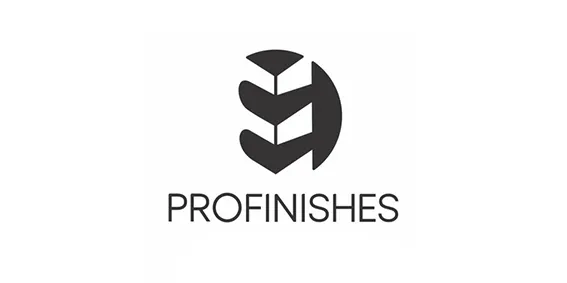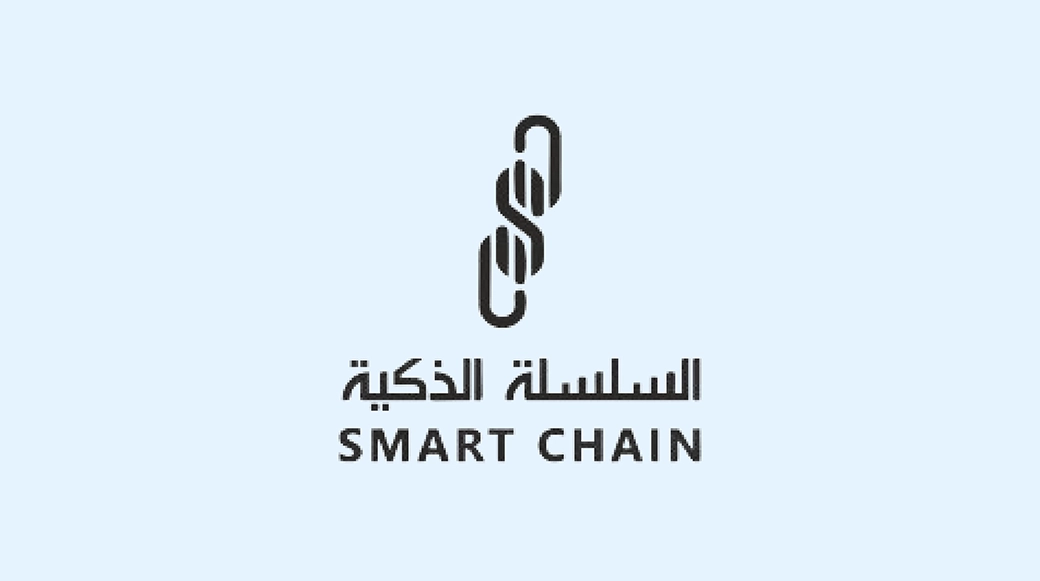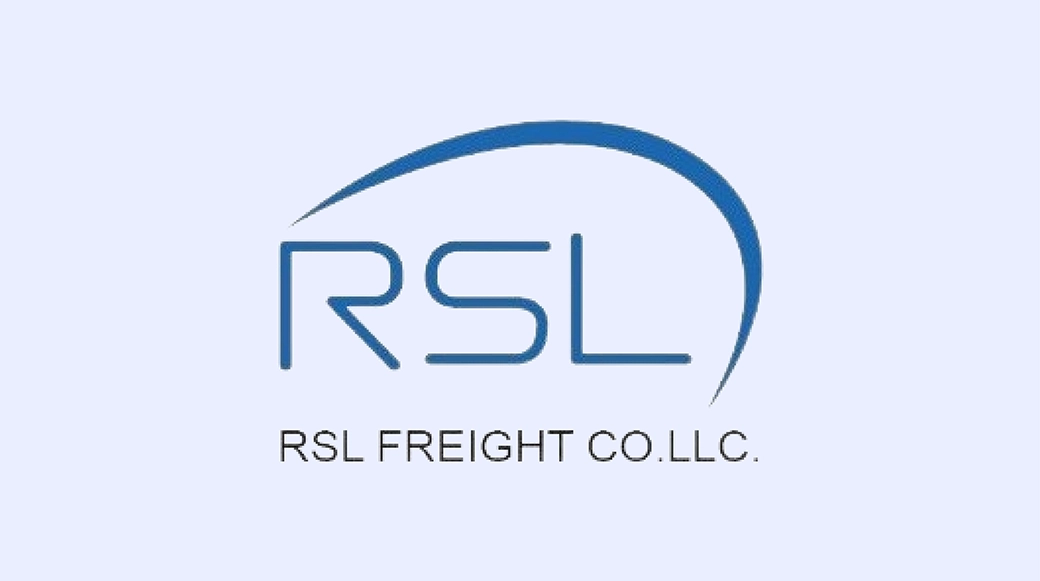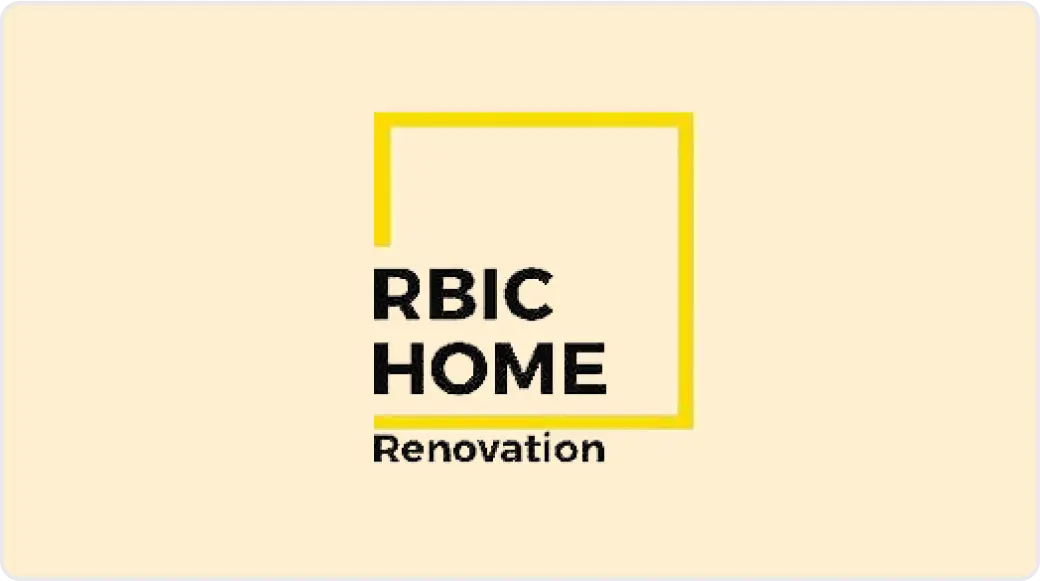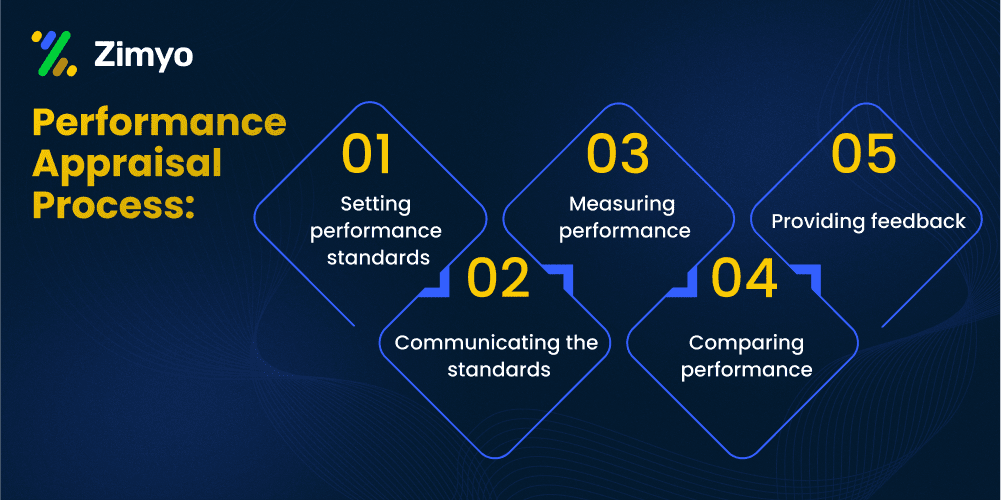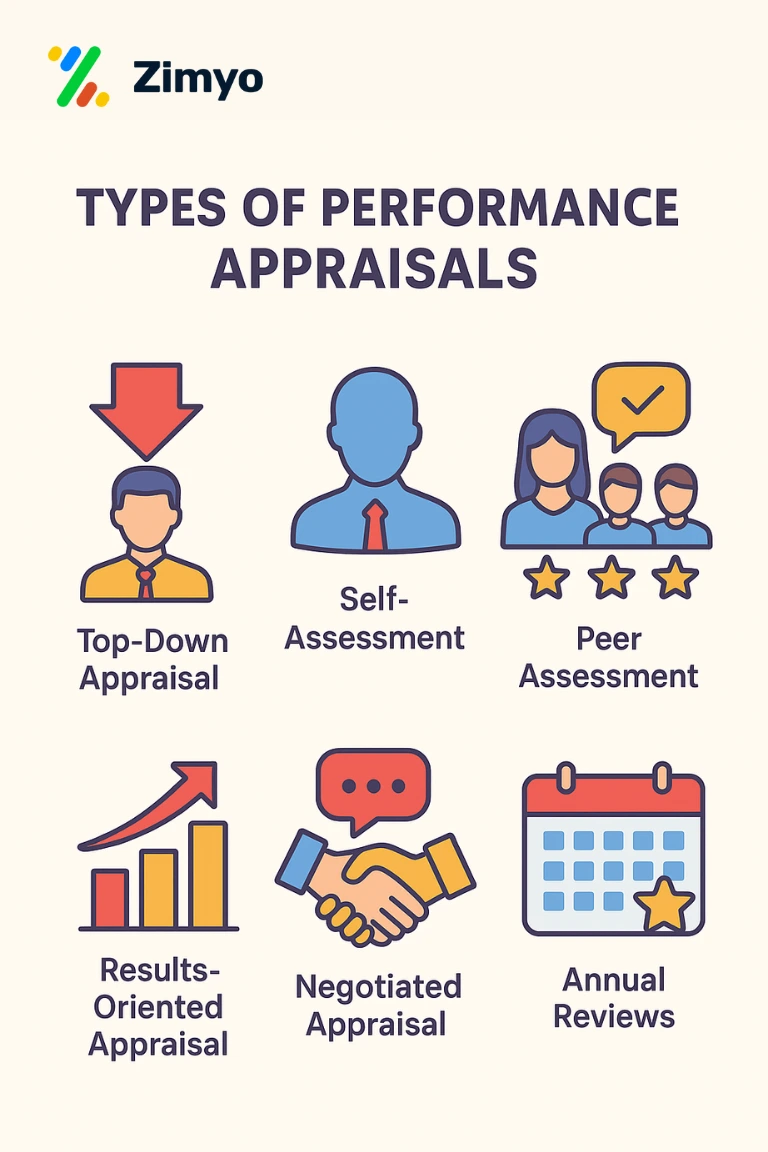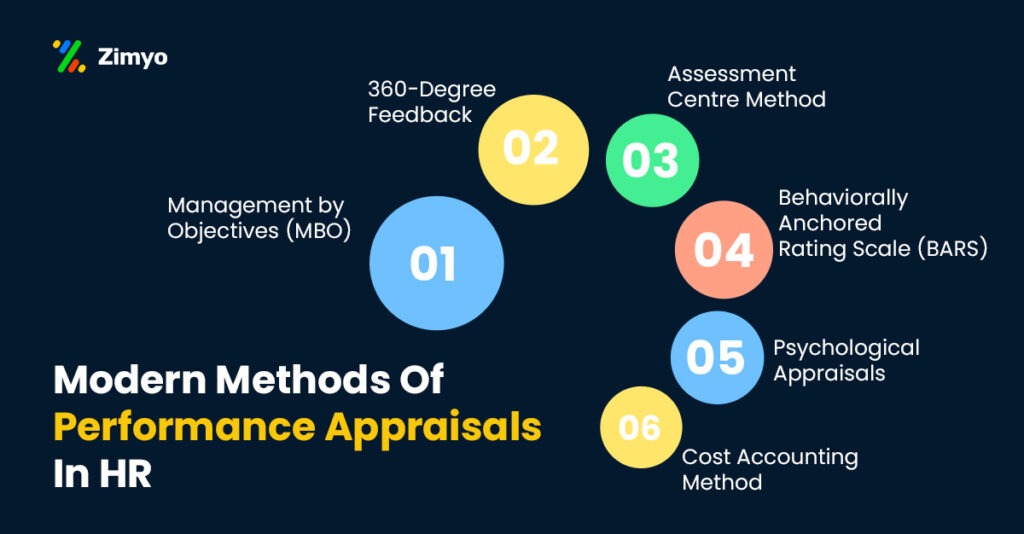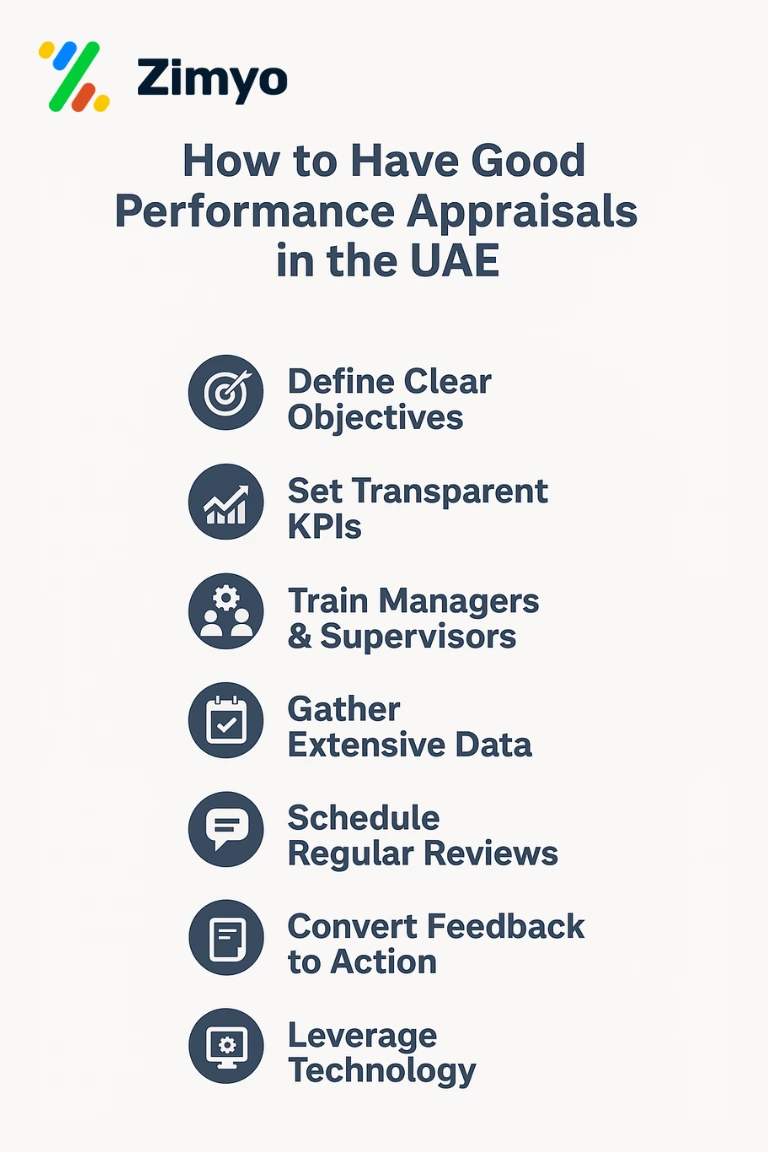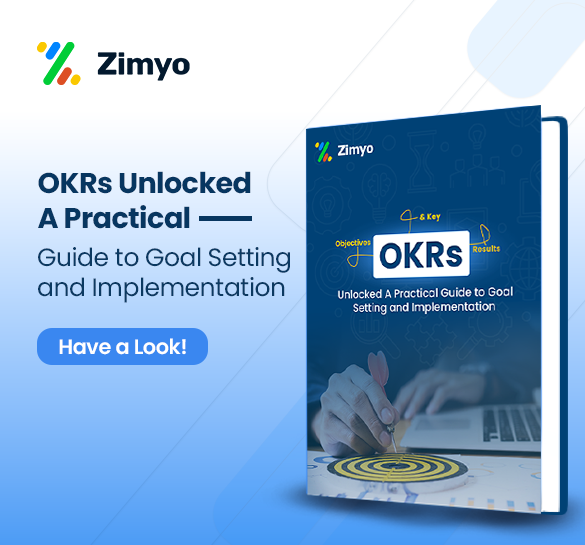Regular appraisals and more recognition go a long way in motivating teams to deliver their best productivity, upgrade skill set and contribute meaningfully to business goals. In developing economies such as the UAE, where talent acquisition is highly competitive, a well-thought-out and efficient performance appraisal process can assist organizations to deliver improved outcomes and create winning teams.
85% of the UAE working population is disengaged at work, and almost 60% of working professionals plan to resign, as stated in the OKR Impact Report. Also lack of recognition and appreciation are part of the leading causes for this disengagement. An employee reward system that recognizes and rewards employees for their achievements, as part of an effective Performance appraisal process, can greatly attrition and assist businesses to stay competitive in the regional talent market.
This guide discusses:
- What appraisals are done for performance
- Difference between performance management and appraisals
- Purposes and advantages of appraisals
- Various types and approaches
- Common pitfalls and how to steer clear of them
- Step-by-step guide for HR leaders to undertake successful appraisals
- The use of technology in making the process
What is Performance Appraisal
A performance appraisal is a formal review of an employee’s work output during a predefined interval. It assesses:
Work Quality & Efficiency – The quality of how tasks are accomplished relative to established standards
Skills & Competencies – Technical, people, and leadership competencies of the employee
Achievements & Milestones – Contributions to personal and organizational success
Behavior & Attitude – Collaboration with the team, flexibility, and cultural alignment
Growth Potential – Potential for career growth or leadership advancement
In the multicultural workforce of the UAE, appraisals also serve the purpose of bringing cultural gaps between the organizations and their employees closer together, foster inclusivity, and integrate diverse teams towards a common organizational goal.
Difference between Performance Management and Performance Appraisals
There is a difference between oth the terms. Lets discover more with difference
Aspect | Performance Management (Ongoing Process) | Performance Appraisals (Periodic Evaluation) |
Nature | Strategic and consistent, continuous process | Conducted once a year, twice a year, or quarterly |
Focus | Improving performance through guidance and support | Measuring and rewarding past performance |
Key Elements | – Establishing SMART goals– Regular coaching & feedback- Identifying training/upskilling needs- Building engagement & motivation | – Evaluating previous performance- Recording successes & weaknesses- Determining pay increases, promotions, awards- Directing future goals & career development |
Timeframe | Ongoing throughout the year | Periodic (annual, bi-annual, or quarterly) |
Primary Objective | Enhance and develop employee performance | Assess performance and provide rewards/recognition |
Outcome | Continuous improvement and employee growth | Documentation of performance and decisions on pay, promotion, or recognition |
Relationship | Aims to improve employee performance over time | Aims to measure and reward performance |
Best Practice | Should be integrated with appraisals for maximum effectiveness | Works best when combined with ongoing performance management |
Shaping the Workforce with Smarter Appraisals Today
Purpose of Performance Appraisals in UAE
The goals of a formalized appraisal process are:
- Evaluation: Quantify contributions to established KPIs and skills.
- Recognition: Reward accomplishment, increase morale, and establish standards.
- Feedback & Coaching: Give constructive feedback for personal and career development.
- Talent Alignment: Connect individual goals to organizational strategy.
- Succession Planning: Identify high-potential employees for future leadership positions.
- Retention: Minimize attrition by engaging employees and making them feel valued.
Key Benefits of Performance Appraisals
A well-structured performance appraisal process does more than gauge past performance—it molds the future of organizational accomplishment and employee development. The main benefits are discussed below in detail:
Manage Appraisal with Performance Management in UAE
Manage appraisals seamlessly with performance management in the UAE—align goals, recognize talent, and boost engagement. Transform reviews into a strategic tool for growth and retention.
1. Goal Alignment
- Helps each employee see how his/her specific tasks tie into the larger organizational vision.
- Decreases confusion by bringing clarity on expectations and quantifiable targets.
- Makes work more fulfilling—employees recognize their day-to-day efforts connected to business impact, be it revenue increase, customer satisfaction, or innovation.
2. Career Growth & Development
- Identifies skill gaps and training opportunities with LMS at the individual and team levels.
- Offers employees formal development roadmaps (training plans, mentorship, certifications).
- Promotes career development by identifying employees qualified for stretch jobs, cross-functional assignments, or leadership programs.
3. Increased Engagement
- Recognition during performance appraisals enhances motivation and employee morale.
- Fosters a culture of feedback in which communication between employees and managers is open and constructive.
- Motivation increases when employees are valued, heard, and led—eliminating disengagement risk.
4. Top Talent Retention
- Fairly rewards high performers and publicly recognizes them, eliminating the temptation to switch to the competition.
- A formal evaluation system guarantees transparency and equity, fostering confidence in employee management decision-making.
- Retention avoids businesses in the UAE money, with the cost of replacing experienced professionals potentially high and time-consuming.
5. Development of Leadership Pipeline
- Performance reviews enable HR to identify top talent who may assume future leadership positions.
- Organizations can develop these workers through succession planning, leadership development, and mentoring.
- Constructs a sustainable talent pipeline—essential for UAE businesses operating in a rapidly changing market.
Types of Performance Appraisals
Various types of appraisals cater to different organizational requirements. The type to be used depends on company culture, objectives, and structure.
1. Top-Down Appraisal
- How it operates: Managers or supervisors review employees' performance
- Ideal for: Companies with a hierarchical organization, where there is a clear line of reporting.
- Strength: Easy to implement, structured, and straightforward.
- Limitation: Might be less peer-influenced and self-assessment, so potentially more biased.
2. Self-Assessment
- How it works: Staff members review their own performance against pre-established standards.
- Best for: Fostering self-awareness and individual responsibility.
- Strength: Provides staff members with time for introspection on accomplishments and challenges.
- Limitation: Can result in understatement or exaggeration of performance, necessitating manager calibration.
3. Peer Assessment
- How it works: Peers give feedback on the skills, teamwork, and contributions of other colleagues.
- Ideal for: Positions with high team and cross-functional collaboration.
- Strength: Offers a balanced perception of performance apart from manager rating.
- Weakness: Danger of bias if peer relationships are not good.
4. Results-Oriented Appraisal
- How it works: Judgments are based on results and KPIs realized.
- Ideal for: Sales, operations, and positions with quantitative objectives.
- Strength: Straightforward and easy to quantify.
- Limitation: Does not consider only results, but may overlook teamwork, creativity, or effort.
5. Negotiated Appraisal
- How it works: Judgments are based on results and KPIs realized.
- Ideal for: Sales, operations, and positions with quantitative objectives.
- Strength: Straightforward and easy to quantify.
- Limitation: Does not consider only results, but may overlook teamwork, creativity, or effort.
6. Annual Reviews
- How it works: Conventional annual performance review.
- Best used for: Organizations with steady processes or less dynamic sectors.
- Strength: Offers a snapshot of the full year's performance.
- Limitation: Can be perceived as old-fashioned in dynamic industries where real-time will be required.
Smarter Appraisals for a Stronger Workforce with Zimyo
What are the Performance Appraisal Methods?
Organizations can use various methods of assessment based on their culture, structure, and business requirements.
1. Management by Objectives (MBO)
How it works: Employees and managers jointly establish SMART objectives (Specific, Measurable, Achievable, Relevant, Time-bound).
Strength: Fosters ownership of outcome and conformity to firm strategy.
Example: A UAE retail firm may have sales growth objectives linked to Vision 2030 objectives.
Limitation: It is successful depending on how clearly goals are set and tracked.
2. 360-Degree Feedback
How it works: Gathers feedback from various sources—peers, subordinates, supervisors, and even customers.
Strength: Gives an all-around, multi-view of performance.
Best suited for: Multicultural, diverse groups (such as those in the UAE), where teamwork is key.
Restriction: Can be difficult to administer and needs confidentiality to allow truthful feedback.
3. Essay Approach
How it works: Managers complete a written report of length that summarizes an employee’s weaknesses, strengths, achievements, and potential.
Strength: Allows depth and context that goes beyond figures.
Best suited for: Small or medium-sized teams where individualized feedback is critical.
Limitation: Subjective and time-consuming—much depends on writing ability of manager.
4. Behaviorally Anchored Rating Scales (BARS)
How it works: Employees are rated against pre-established behaviors associated with job performance.
Strength: Minimizes ambiguity by measuring observable acts, rather than nebulous traits.
Example: Measuring “team collaboration” on a 1 (rarely contributes ideas) to 5 (actively facilitates group discussion) scale.
Limitation: Needs meticulous design and calibration in order to be effective.
5. Critical Incident Method
How it works: Evaluations emphasize particular positive or negative events representing employee performance and behavior.
Strength: Encourages managers to notice outstanding contributions as well as to immediately address severe issues.
Example: Documentation of when an employee resolved a significant client crisis or missed an important deadline.
Limitation: Depends on regular documentation and can miss overall performance patterns.
With 85% of the UAE workforce disengaged, a robust performance appraisal system is no longer optional—it’s essential.
Downsides of Poorly Conducted Appraisals
If done well, performance appraisals can be an effective tool for development and motivation. Yet, if done poorly, they can do the reverse—engendering disappointment, mistrust, and increased turnover. The following are the major pitfalls of poorly run appraisal systems:
1. Demotivation
Problem: People feel underappreciated or overlooked when feedback is unclear, biased, or unreasonable.
Impact: Rather than motivating employees, appraisals can demotivate employees, causing disengagement and reduced productivity.
UAE Context: With close to 85% of UAE’s workforce already disengaged (OKR Impact Report), demotivation due to poor appraisals can exacerbate the issue and reinforce the desire to quit.
2. Trust Issues
Issue: Employees’ perceptions of biased, uneven, or politically driven appraisals weaken their trust in leadership.
Impact: This creates a poisoned work environment where workers question managerial transparency and fairness.
UAE Context: In an international working environment where transparency and openness are emphasized, discriminatory appraisals can isolate intercultural employees, lessening cooperation and harmony.
3. Excessive Focus on Numbers
Problem: Certain organizations narrow down the measurement of performance to hard-numerical KPIs alone and exclude soft skills, creativity, innovation, and team effort.
Effect: Employees begin to feel more like numbers than contributors, which degrades
From Reviews to Real-Time Development
How to Have Good Performance Appraisals in UAE
To secure fairness and effect, HR professionals may do the following:
1. Define Clear Objectives
- Establish whether the focus is recognition, development, or alignment.
- Ensure the purpose of performance management is clearly defined before implementation.
2. Set Transparent KPIs
- Create role-specific, measurable targets that directly align with company strategy.
- Clearly communicate expectations to all employees.
3. Train Managers & Supervisors
Provide workshops on:
- Delivering effective feedback
- Maintaining objectivity and fairness
- Ensuring consistency across evaluations
4. Gather Extensive Data
5. Schedule Regular Reviews
- Move beyond annual reviews.
- Implement quarterly or project-based feedback sessions for continuous improvement.
6. Convert Feedback to Action
- Develop personalized development and training plans.
- Offer resources such as:
- Learning materials
- Mentorship opportunities
- Stretch assignments/projects
7. Ensure Legal Compliance
- Adhere to UAE Labour Law requirements.
- Uphold non-discrimination and fairness practices in evaluations.
8. Leverage Technology
Adopt AI-enabled platforms to:
- Monitor performance in real time
- Automate reminders for check-ins with Time and attendance
- Generate actionable performance insights and analytics
- Integrate seamlessly with payroll, recruitment, and learning management systems
69% of businesses in UAE now transparently link employee objectives with leadership priorities, making performance appraisals more aligned and meaningful.
Example Questions for a Performance Appraisal Questionnaire
List of Questions are given below-
1. Overall Performance
- How would you rate your performance for the last year?
- Do you consider that you effectively met your KPI or set goals?
- What achievement are you most proud of this year?
2. Teamwork & Collaboration
- How would you rate your ability to work with colleagues?
- What steps have you taken to improve communications in your team?
3. Goals & Career Growth
- What work objectives do you wish to address over the next year?
- What vestibule training, equipment, or assistance would enable you to meet these objectives?
4. Feedback & Improvement
- Do you believe that you get timely and helpful feedback from your manager?
- What are some ideas for improving the appraisal process?
Conclusion
Performance appraisals are more than a bureaucratic chore—They are a strategic HR weapon for linking talent to organizational objectives, enhancing engagement, and shaping the future.
By embracing clear goals, open metrics, ongoing feedback, and technology, UAE organizations can develop an appraisal system that:
- Encourages employees
- Fosters trust
- Lessens attrition
- Recognizes and develops leaders of the future
Zimyo platforms enable HR departments to shift from traditional yearly reviews to AI-driven, real-time performance management with fairness, transparency, and quantifiable business impact. Schedule a demo soon to have a better performance management for your organisations in UAE.
Driving Business Success Through Employee-Centric Appraisals
FAQs (Frequently Asked Questions)
Historically once yearly, although today most UAE firms have quarterly or semi-annual appraisals with regular informal check-ins.
Zimyo’s AI-driven system assists HR professionals in:
- Setting SMART goals
- Automatically tracking performance
- Gathering 360-degree feedback
- Creating data-driven appraisals reports
- Merging performance with payroll and recruitment
Yes. Equitable, transparent appraisals increase motivation through rewarding contributions and offering growth opportunities. Poorly conducted appraisals, on the other hand, decrease trust and promote turnover. And this is a complete blown-out, feature-rich guide — organized, application-focused, and extremely beneficial for HR practitioners.
The key elements are measurement, feedback, positive reinforcement, open discussion, and goal-setting for improvement
Zimyo is a leading performance management software in Dubai, offering real-time tracking, 360° feedback, and analytics.
It involves setting objectives, monitoring performance, evaluating results, giving feedback, and planning development actions.
What People Think About Zimyo
